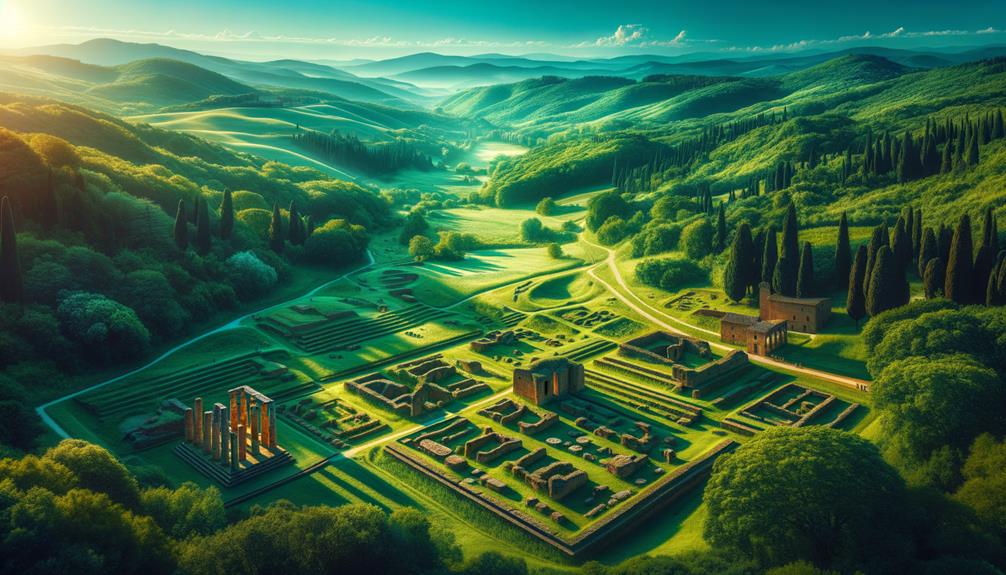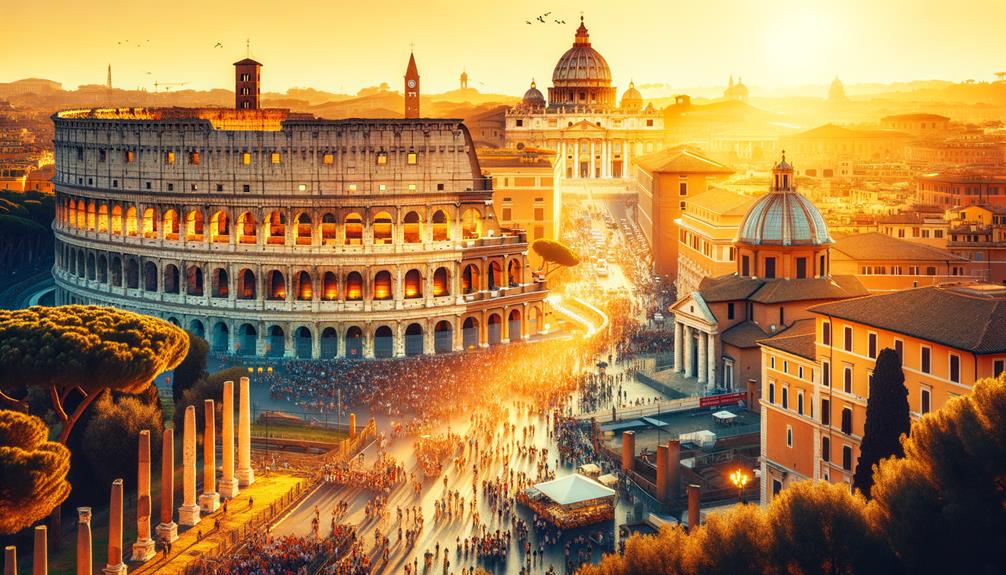Strolling through the Etruscan sites in Grosseto, I felt a profound connection to an ancient world rich in culture. The pottery, jewelry, and artifacts at the Museum of Maremma whispered tales of a highly sophisticated society. At the Roselle Archaeological Area, the ruins seemed alive with the daily rhythms of Etruscan life. The tombs at Vetulonia and Poggio Tondo offered a solemn yet intriguing look into their burial customs. As I wandered through Città del Tufo Park, I couldn't help but marvel at the craftsmanship behind these artifacts and wonder what more they reveal about this mysterious civilization.
Museum of Maremma
The Museum of Maremma, located in the heart of Grosseto, offers a captivating glimpse into the region's rich Etruscan heritage. Walking through its doors, I immediately felt the weight of history. The museum's carefully selected artifacts vividly illustrate the ancient Etruscan civilization that once flourished here. Each exhibit seemed to unlock a piece of the past, offering a sense of freedom as I wandered through the halls.
The artifacts on display are truly mesmerizing. From intricately designed pottery to finely crafted jewelry, each piece tells a story. Detailed descriptions provided context, helping me connect with the people who created and used these objects. The archaeological significance of Grosseto's Etruscan sites is evident throughout the museum.
A standout for me was the section dedicated to the everyday lives of the Etruscans. Seeing how their culture influenced the region's development was humbling. The Museum of Maremma doesn't just display artifacts; it brings history to life. My time there deepened my appreciation for the Etruscan legacy and left me eager to discover more of what Grosseto has to offer.
Roselle Archaeological Area
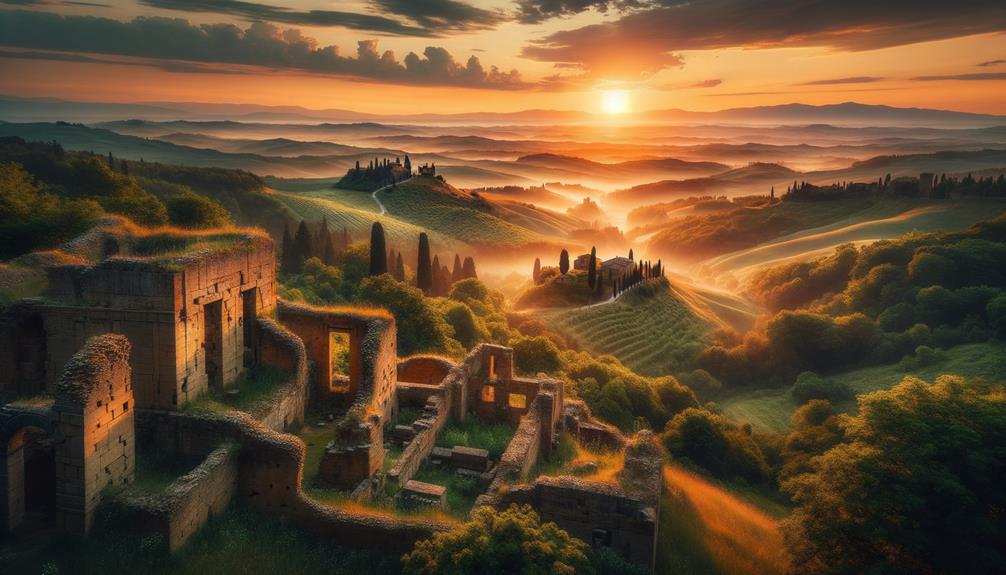
Just a few kilometers from Grosseto, the Roselle Archaeological Area offers a captivating glimpse into the ancient Etruscan world. Walking along the cobblestone paths of this once-thriving city, I felt a deep connection to the past. The well-preserved ruins narrate the story of a sophisticated society that existed long before Rome's ascendancy.
The Roselle archaeological area is more than just a historical site; it's like stepping back in time. The ancient walls that once fortified the city still stand, defying the ages. In the necropolis, the grave goods unearthed offer a vivid picture of Etruscan customs and daily life. Each artifact, from pottery to jewelry, reveals much about the people who lived here.
As I wandered through the remnants of this ancient city, I felt a sense of freedom. The expansive views over the Maremma countryside and the whispers of history carried by the wind made me appreciate the enduring beauty and resilience of human culture. The Roselle Archaeological Area is indeed a rich repository of Etruscan heritage, waiting to be explored.
Vetulonia
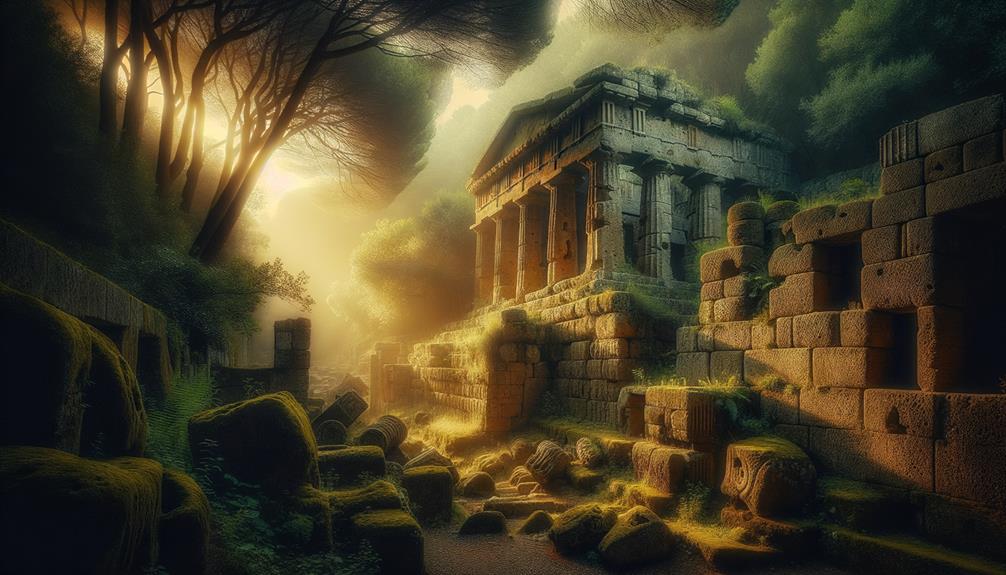
Walking through the ancient tombs of Vetulonia, I could almost hear whispers of the past beneath my feet. Over a thousand graves tell stories of long-gone lives. The Isidoro Falchi Archeological Museum, filled with Etruscan artifacts, gives a closer look at their advanced metalwork and everyday life. Each item, from detailed bronze pieces to graceful pottery, felt like a direct link to the artisans who once thrived in this lively city.
Ancient Tombs Discovery
Finding the ancient tombs of Vetulonia gave me a deep sense of connection to the Etruscan civilization's lasting influence. Strolling through the necropolis of Poggio Tondo, I was struck by the detailed stone carvings and the immense size of the tombs. This archaeological site in Tuscany feels like a journey back in time, unveiling history layer by layer.
The tombs, with their weathered exteriors and enigmatic interiors, seemed to tell stories of a people who once flourished here. The Etruscans, celebrated for their artistry and engineering, built these burial sites with a deep respect for the afterlife that is still evident today. Each tomb stands as a testament to their beliefs, craftsmanship, and bond with the land.
As I delved deeper, I thought about how vital it is to preserve these sites. These tombs are not just ancient remnants; they offer a window into a culture that cherished freedom, community, and the cycles of life and death. In the serene Tuscan hills, surrounded by these ancient stones, I felt a profound connection to those who lived here long ago.
Archaeological Museum Highlights
Walking into the Archaeological Museum of Vetulonia, known locally as the Museo Civico Archeologico Isidoro Falchi, I was instantly drawn in by the well-preserved artifacts that paint a vivid picture of Etruscan life. This museum is a tribute to the grandeur of Etruscan cities and their civilization, which flourished in the first millennium BCE.
The exhibits, unearthed through dedicated archaeological efforts, are truly captivating.
Intricately designed gold jewelry showcases the Etruscans' craftsmanship and sense of beauty.
Beautifully decorated funerary urns give us a peek into their burial customs and beliefs about the afterlife.
Detailed bronze statuettes highlight the artistic skill of ancient Etruscan metalworkers.
Vessels adorned with stunning motifs offer insights into their daily life and trade.
As I moved through the galleries, I felt a profound connection to this ancient culture. Each artifact told its own story, making the distant past feel surprisingly close. The museum is more than just a collection; it's a journey through time that brings the Etruscans' world to life.
Scarlino

Tucked away in the hills of Tuscany, Scarlino offers a captivating look into Etruscan history that feels timeless. As I stroll through this charming village, I can almost sense the ancient presence of the Etruscans, who once flourished in this area. The southern part of Tuscany is rich in Etruscan heritage, and Scarlino is no different. One of the most fascinating sites here is the Poggio, where the remains of an Etruscan temple stand as silent witnesses to a bygone era.
As I explore the ruins, the air is thick with the scent of wild herbs and the warmth of the Tuscan sun. The foundation stones of the Etruscan temple are intricately laid, hinting at the grandeur that once existed. I can almost picture the Etruscans gathering here, their rituals and daily lives intertwined with the natural landscape.
Scarlino itself, with its narrow streets and sweeping views, feels like a bridge between past and present. There's a profound sense of freedom in wandering through these ancient sites, serving as a reminder of the enduring human spirit. The echoes of Etruscan civilization still resonate strongly in Scarlino, a legacy that continues to inspire.
Poggio Tondo Excavations
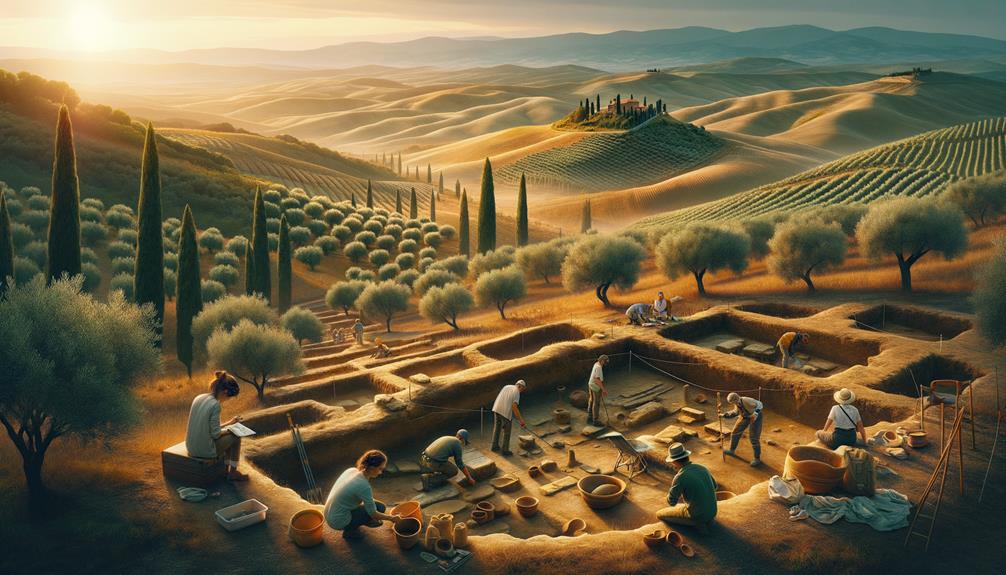
Standing at the Poggio Tondo excavation site, I'm immediately struck by the ancient tombs that reveal the Etruscans' intricate burial customs from the 7th and 6th centuries BC. This open-air archaeological site is part of the Archaeological Park of Chianciano Terme and showcases the rich heritage of the Etruscan civilization. As I wander through the area, I can't help but feel a deep connection to the past.
The tombs here are more than just graves; they offer glimpses into the lives and beliefs of an ancient culture. What's particularly fascinating about the Poggio Tondo site are the discoveries made during the excavations:
- Pottery: Beautifully crafted pieces that tell stories of daily life and artistic skill.
- Jewelry: Detailed adornments hinting at the social status and personal tastes of those buried here.
- Grave goods: Items that highlight the cultural and economic exchanges between the Etruscans and their contemporaries.
- Burial customs: The tombs themselves, reflecting the spiritual and ritualistic practices of the time.
Exploring Poggio Tondo, I realize that archaeology isn't just about digging up artifacts; it's about understanding the human stories behind them. This site is a must-visit for anyone passionate about Etruscan history and the mysteries it holds.
Città Del Tufo Park
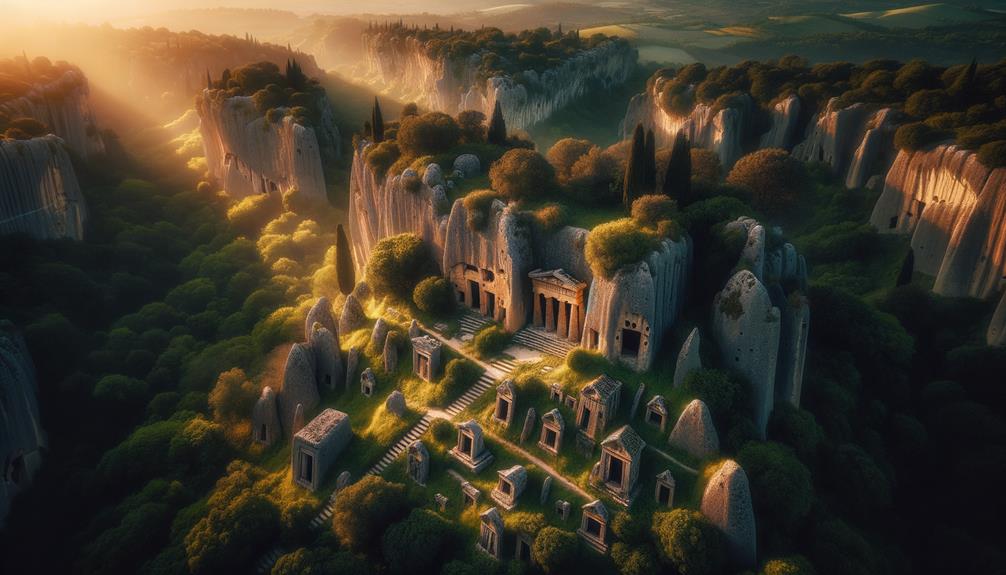
Strolling through the Città del Tufo Archaeological Park, I can't help but marvel at how Etruscan ruins seamlessly blend with the lush Tuscan landscape. Located in Sorano, the park covers more than 18 hectares of rolling hills and dense woods, dotted with ancient tombs carved from volcanic tuff stone. The park's name, Città del Tufo, aptly reflects the enduring material that has preserved countless Etruscan secrets over the millennia.
As I walk the trails, I come across the Necropolis of San Rocco and the Necropolis of San Giorgio. These burial sites offer a poignant glimpse into the Etruscans' deep respect for the afterlife. The tombs, some adorned with frescoes and intricate architectural details, reveal a culture intimately connected to its surroundings and spiritual beliefs.
Each step along these paths feels like a journey through time, evoking a profound sense of freedom. The park is more than just an archaeological site; it's a sanctuary where history and nature coexist harmoniously. The Etruscan Museum of Sorano, situated within the park, adds to the experience by providing insights into daily life and customs. The Città del Tufo Archaeological Park truly breathes life into the past, inviting us to explore and reflect.
Etruscan Artifacts and Treasures
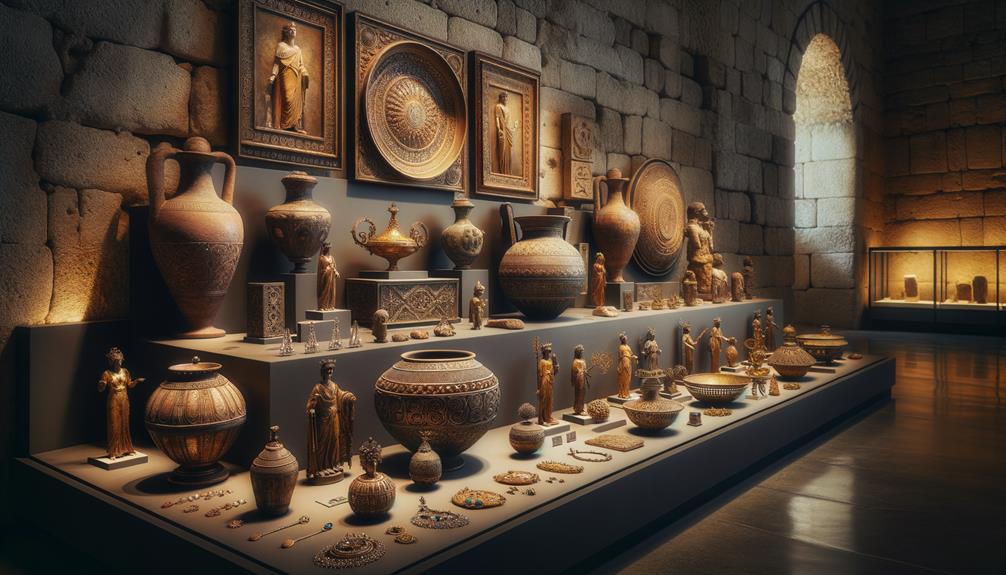
When I saw the intricate jewelry and burial items at the Museum of Maremma, I felt a deep connection to how the Etruscans honored their dead. The detailed craftsmanship of the gold pieces and the ornate urns in Vetulonia showed not just skill but also cultural significance. Each artifact seemed to tell stories of ancient lives, beliefs, and the society that valued them.
Ancient Jewelry Findings
Exploring the rich history of Grosseto, the Etruscan jewelry findings offer a fascinating look into the artistry and cultural sophistication of this ancient civilization. The intricate designs and craftsmanship reveal much about the Etruscan era's social and cultural dynamics. At the Museo Archeologico e d'Arte della Maremma in Grosseto, the gold earrings, pendants, and brooches showcase techniques like granulation and filigree. Each piece seemed to whisper secrets of a bygone age.
- Beautiful gold diadems: Excavations at the Archeological Area in Roselle have uncovered tombs with golden diadems dating back to the 7th-6th centuries BCE.
- Mythological themes: The Isidoro Falchi Archeological Museum in Vetulonia displays jewelry featuring mythological creatures like lions and griffins.
- Everyday life: The Etruscan farm of Poggio Bacherina presents bronze fibulae and amber beads, offering a glimpse into the lives of ancient Etruscan farmers.
- Bucchero bowl: A unique bucchero bowl from the 6th century, inscribed with the Etruscan alphabet, is housed at the Museum of Maremma.
Seeing these artifacts, I felt a deep connection to the Etruscans, whose jewelry work remains timeless, reflecting their lasting impact on archaeology and art.
Burial Site Discoveries
As I admired the delicate jewelry, I couldn't help but think about the burial sites where these treasures were found. Each grave tells a unique story of Etruscan life and death. In the Berardenga region, an important Etruscan hub, burial sites have fascinated historians and archaeologists for years. These sites, dating back to ancient times, offer insights into the society's beliefs about the afterlife and their artistic talents.
Walking through the excavated tombs, I felt a deep connection to the past. The collection of artifacts—bronze mirrors, finely crafted weapons, and elegant pottery—each hinted at the lives they once honored. These discoveries aren't just about the objects themselves but about the stories they tell of a civilization that valued beauty, craftsmanship, and the mysteries of the afterlife.
It's amazing to think that these Etruscan treasures lay hidden for thousands of years, untouched and waiting to be found. Each artifact reflects the Etruscans' rich cultural heritage and their lasting impact. The echoes of their lives, preserved in these burial sites, continue to inspire and intrigue us today.
Frequently Asked Questions
What Does "Grosseto" Mean in Italian?
In Italian, 'Grosseto' refers to a place on a hill. The name has evolved since the Middle Ages but has kept its core meaning. It's intriguing how local dialects preserve history in everyday language.
Is Grosseto Worth Visiting?
Definitely, Grosseto feels like diving into a blend of history and nature. Strolling through its old streets, admiring ancient artifacts, and connecting with the land, it's a hidden gem that's truly worth experiencing.
Are There Any Etruscans Left?
I don't think there are any Etruscans around today, but what they left behind still resonates. When I walk through their ancient ruins and see their artifacts, I feel connected to a culture that cherished freedom, creativity, and individuality. It's truly inspiring.
What Do You Think Was the Most Important Legacy of the Etruscans?
I think the most significant legacy of the Etruscans is how they shaped Roman architecture and engineering. Their use of arches and columns is still impressive today, showcasing their creativity and laying the groundwork for Western civilization's cultural roots.

